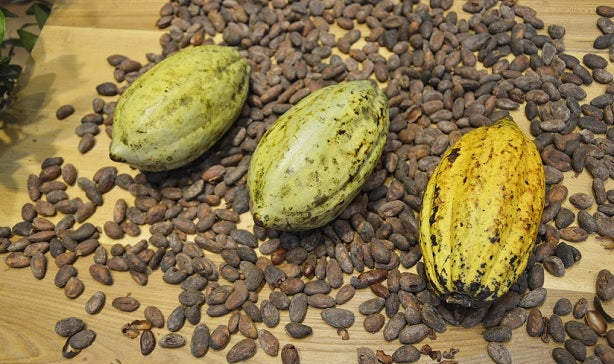Most of the chocolates in today’s world is made by large industrial companies like Mondelez, Nestle and others. Sadly their only priority is to make products at a low cost. The constant chasing of low costs and high profits leads to all the problems that affects our food and therefore us and eventually our planet today. Low quality ingredients. Bad farm practices. Plastic waste. Massive deforestation. And so much harm and pollution from it all. But it does not have to be this way.
Chocolate is one of the most flavourful foods on earth. They contain even more flavour compounds than wine. These flavours originate and become a part of the cacao as it grows – from the soil, the flora of the region where the cacao is grown, how the cacao is fermented, how it is dried and how it is finally roasted. Because of this, chocolate made from cocoa beans from one farm could differ completely from one made from cocoa beans from a different farm just a few kilometres apart. But most companies in search of consistency and low cost end up removing these nuanced flavours.
We are changing how things are done. And this is the story of how we create our chocolate.
The farm
It begins with the cacao. Grown 20 degrees south and north of the equator, in India the cacao trees are grown in the South of India. We visit the farms we source our cocoa beans from, to know the farmers and see how the cacao is grown. Farmers are one of the most important parts of our ecosystem. Sometimes more than the cacao itself. An honest and a humane farmer truly cares about the food that they grow and the goodness in them.

The fruits of the cacao trees are referred to as cacao pods. Large and colourful, they are cut open to remove the seeds that are surrounded by a white fruity mucilage – similar to a custard apple. These very seeds are the cacao beans.

Depending on where the beans are grown, they may be put into wooden boxes or baskets or trays or simply wrapped in banana leaves to ferment. Fermentation develops and heightens flavours and aromas in the cacao bean, some that are intrinsic while some that develop during the process.


Once the beans are fermented well, they are dried to stop the fermentation. Like fermentation, drying techniques vary across the world. Each of these variations in growing and transforming the cacao bean creates the diversity of flavours in the chocolate.
Creating chocolate
Once we receive the beans, we open the bag and sort the beans by hand. Though our farmers make sure the beans are cleaned and sorted before shipping, we look for anything that should not be in the bag and may have in. It could be a leaf, rock and even damaged beans. We just want to make sure our chocolate remains pure. Even amongst the new age chocolate makers, our chocolate is special because we avoid using anything that is harmful, not natural and highly processed to create the most flavourful chocolate. It is as raw as it can get.
After sorting, we roast our cocoa beans. We prefer roasting them at low temperatures. This preserves the true flavour of the bean which is lost when roasting at high temperatures. As the moisture and microflora levels drop, the flavour also intensifies.
The beans are then broken and winnowed to separate the shell from the nibs which is the core of the bean.

We create chocolate in small batches. Depending on the chocolate we are making, we grind the nibs with raw sugar or other ingredients in a melangeur for a minimum of two days. A melangeur is a stone grinder that crushes the beans into smaller and smaller particles and transforms them into liquid chocolate or chocolate liquor as it is called. The heat produced during the grinding also evaporates the unpleasant flavours.

Chocolate contains unstable fat crystals which take up many forms depending on the temperature. Tempering creates a stable crystal structure and transforms liquid chocolate into a chocolate bar that does not melt at room temperature. Quite simply in tempering, we heat chocolate, cool it down and then heat it slightly once again while agitating it constantly.
It is then poured into moulds and cooled. This gives us a chocolate with a beautiful shine, a snap when broken and a melt in the mouth texture – the three qualities of a good chocolate.
Once cooled, it is demoulded and hand-wrapped in foil. Then we enclose it in recycled paper and ship them out fresh to you!


Share:
Is Dutch Process Cocoa bad for you?
Different varieties of chocolate